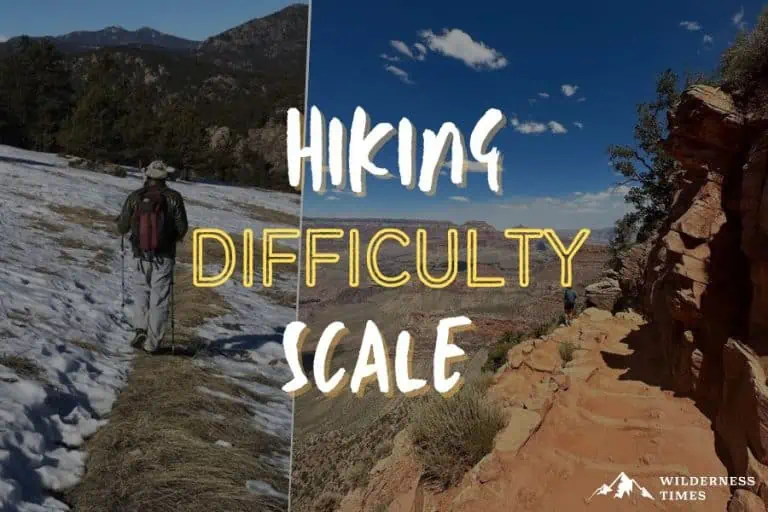Not everyone can hike the same trails. Some hikes are too difficult for some people. That’s why understanding the hiking difficulty scale will help you be a better hiker.
Difficulty ratings can help you plan your hike better based on your abilities and physical fitness to perform various types of hikes.
It’s important to gradually increase the difficulty of your hiking trips as you get better at hiking.
Of course, if you have any health issues, you should consult your practicing physician beforehand to ensure you can safely increase your hiking levels.
When I first started hiking, I was overweight and not in shape. I had to do easy trails and work my way up to moderate ones.
After a decade of hiking, I can take almost any trail out there. But I still don’t think I’m ready for thru-hiking.
To fully understand the hiking difficulty scale, it’s important to break it down and get a glimpse of what each part of it means.
Hiking Difficulty Factors
There is no standardized national or international hiking difficulty scale, unfortunately.
However, there are many different factors that determine the hiking difficulty of a trail.
It’s important to understand these factors to assist you in choosing the best hiking trail based on your ability to hike.
FACTOR | EASY | MODERATE | MODERATELY STRENUOUS | STRENUOUS | VERY STRENUOUS |
Elevation Gain | < 500 ft | 500 to 1,000 ft | 1,000 to 2,500 ft | 2,500+ ft | 2,500+ ft |
Length | < 1 mile | 1 to 5 miles | 5 to 10 miles | 10+ miles | 10+ miles |
Terrain | Fairly Flat | Some hills, streams/creeks | Hills, rocky areas, streams/creeks | Mountainous, off-trail navigation | Requires climbing, mountainous, off-trail navigation |
Trail Type | Loop, lollipop, out-and-back | Loop, lollipop, out-and-back | Loop, out-and-back | Out-and-back, point-to-point | Out-and-back, point-to-point |
Terrain
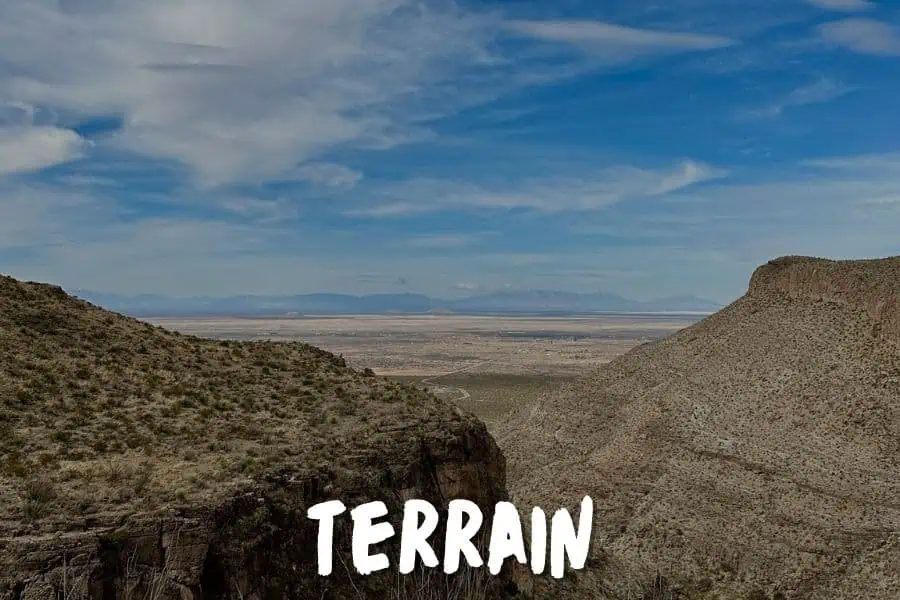
The terrain is an important factor to consider.
An easy hiking trail will have easy terrain.
A moderate hiking trail will be a bit more wild and rugged.
A strenuous hike will have more hills, and a very strenuous hike will practically involve mountain climbing and dangerous conditions like avalanches.
Elevation Gain
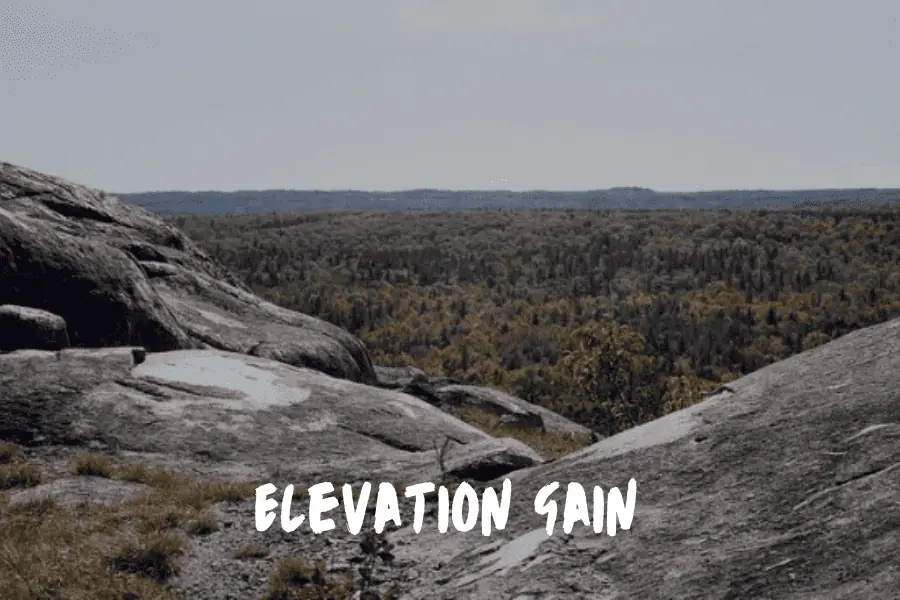
Elevation gain can also help you determine the difficulty of a hiking trail.
If the elevation gain is 300 feet, the trail will be fairly easy to hike.
The higher the maximum elevation gain, the hillier and harder the hike will be.
Most tougher hikes in my area have around 1,000 to 2,000 feet of elevation gain.
Rolling hills and steeper conditions require more hydration, fueling, and rest.
You might see elevation gains of 8,000 feet or more if you hike in the mountains.
It gets really difficult to hike if you’re not prepared for that.
Altitude is like the elevation factor on steroids.
Once we start to talk about altitude, we’re no longer talking about hiking, but more along the lines of mountaineering.
Some people who are not used to high altitudes might get altitude sickness, which can include flu-like symptoms.
Luckily, they make over-the-counter medication to help hikers cope with these issues.
Weather & Climate
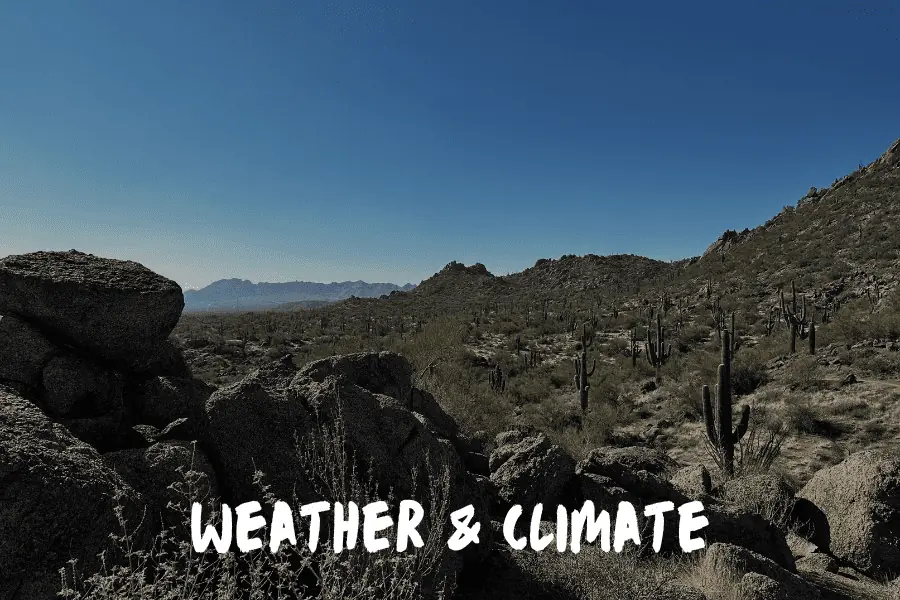
Weather and climate will always play a role in trail difficulty ratings, too.
Some mountainous regions will have deep snow, blizzards, and avalanche conditions.
These factors would make a trail very strenuous, to say the least.
In my area, heavy rain will mean that trails will be extra muddy, and creeks could become too high to cross safely.
Understanding the weather and climate of any area you plan to hike is important.
Read: Hiking in Hot Weather
Personal Fitness & Experience
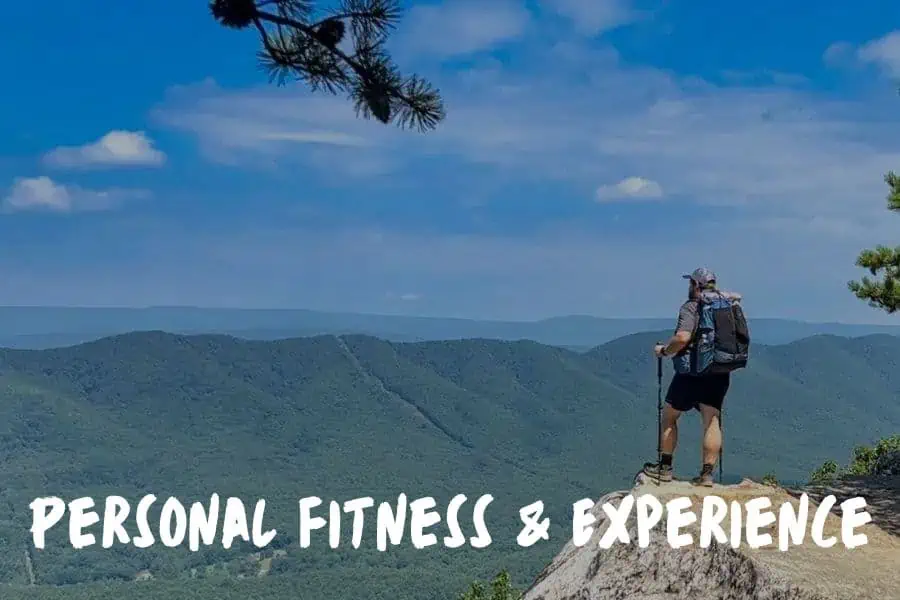
Your fitness and hiking experience level matter in the hiking difficulty scale.
You must be in great physical shape to hike a strenuous route.
That means you must have a healthy weight, muscle development in all the right places, and experience hiking in rugged conditions.
If you’re not in the right physical fitness and or don’t have the proper experience level for some harder hikes, you could get hurt.
If you have health problems, you should always check with your physician before taking on harder hikes.
Basic Types Of Hikes
Every hiking difficulty scale will consider the above factors, just give the levels of hikes different labels.
As a general rule of thumb, most hikes can be described as easy, moderate, moderately strenuous, strenuous, or very strenuous.
While there is not a standardized hiking difficulty scale, all hiking difficulty scales do the same thing: help you figure out which trails are best suited to your abilities.
Hiking Difficulty: A Quick Comparison
FACTOR | EASY | MODERATE | MODERATELY STRENUOUS | STRENUOUS | VERY STRENUOUS |
Elevation Gain | < 500 ft | 500 to 1,000 ft | 1,000 to 2,500 ft | 2,500+ ft | 2,500+ ft |
Length | < 1 mile | 1 to 5 miles | 5 to 10 miles | 10+ miles | 10+ miles |
Terrain | Fairly Flat | Some hills, streams/creeks | Hills, rocky areas, streams/creeks | Mountainous, off-trail navigation | Requires climbing, mountainous, off-trail navigation |
Trail Type | Loop, lollipop, out-and-back | Loop, lollipop, out-and-back | Loop, out-and-back | Out-and-back, point-to-point | Out-and-back, point-to-point |
Easy Hikes
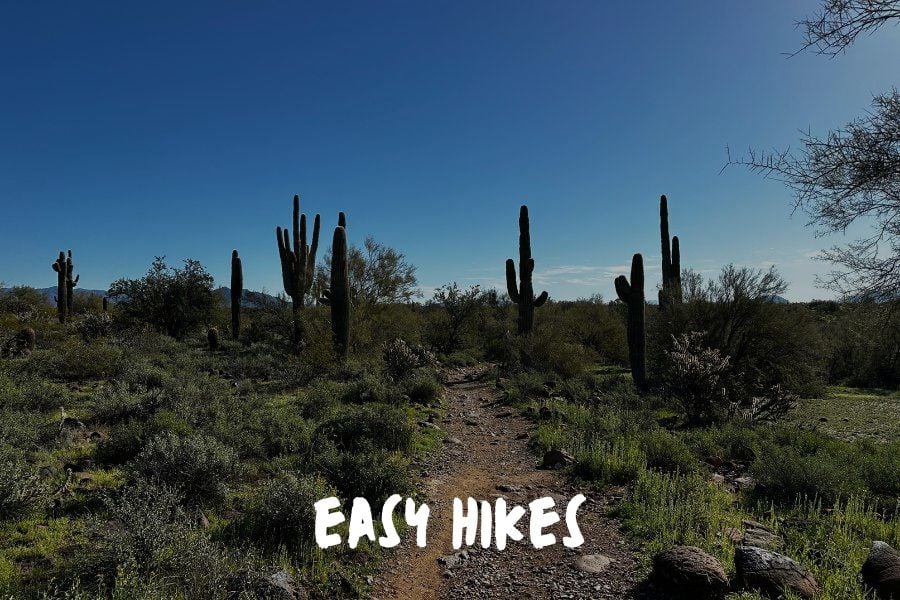
Most beginners should start out going on trails labeled as “easy”.
This will introduce them to hiking and allow them to build up their hiking abilities.
But easier hikes are also ideal for different types of people.
For young children and parents with young children, an easier hike will allow them to enjoy nature without it being too difficult for the children.
Many easy hikes typically have much to see to keep children occupied.
Easy hikes are also ideal for older hikers who cannot do harder hikes because of age and/or disabilities.
Elevation Gain
Most easy hikes have minimal elevation gain. This means they won’t have too many hills or hard-to-climbing sections.
So, you won’t end up 2,000 feet above where you initially started.
The higher the elevation gain, the hillier you should expect the trail to be.
Hilly trails are going to be harder to hike and will require more hydration, fuel, and rest.
Terrain
Easy trails are typically found in state parks, nature preserves, and national forests/parks.
It’s safe to say that you can expect easy-rated hiking trails to be fully maintained all year long.
That’s because these trails cost less to maintain and frequently attract more people.
They also don’t even require much signage aside from junction navigation.
So many people have used them that the path is usually obvious.
Length
Easy-rated hiking trails are usually short in length, too.
You will find most of them to be less than half a mile, or around a mile at most.
Trail Types
Easy trails can really be any type. Most are loop trails, meaning you will create a circle around an area, but start and end at the same trailhead.
Some may be “lollipop” loops, which are a combination of an out-and-back and loop trails.
They get their name because they make a shape like a lollipop.
There will be a loop around the midpoint of the trail.
When you’ve completed that portion, you will then rejoin the part of the trail you started on to get back to the trailhead.
The last type of easy trail are out-and-back trails.
For this type of trail, you basically take a trail to a dead end, then retrace your steps back to where you started.
Best for: beginner/inexperienced hikers
Moderate Hikes
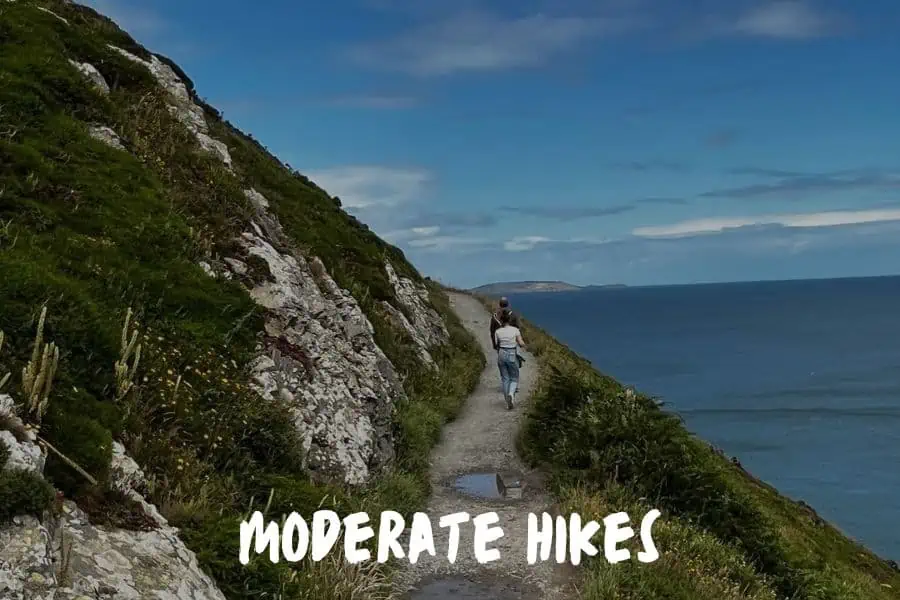
Moderate hiking trails are geared toward people who have gained enough experience with hiking that easy trails are too easy.
These hikes typically require that you be more physically fit.
You’ll find that there are often more moderate hikes in an area than there are easy hikes.
Many hikers prefer moderate trails for their casual hikes, so they tend to be the most common hiking trails available.
Elevation Gain
You can expect some elevation gain on moderate hikes.
Typically, I gain about 800 to 1,000+ feet of elevation on moderate hikes and under 500 feet on easier hikes.
Moderate hikes tend to have hillier conditions, requiring more hydration and rest.
It’s very important to stay hydrated on these trail types because elevation gain plays a role in wearing you down and using your body’s salt and water.
Terrain
Uneven terrain should also be expected on moderate hikes.
This will include creek and stream crossings, roots, rocky surfaces, and switchbacks to get up hills easier than just going straight up them.
Note: Switchbacks are hillside trails that have a zigzag pattern.
The sharp turns allow the hiker to take the elevation gain at a consistent and steady pace.
Some hikers and horseback riders will create their own paths that go straight up to avoid switchbacks.
However, this practice is unethical and often leads to severe erosion.
This causes more work for trail maintenance, so it’s just best to stay on the designated trail at all times.
Moderate trails are usually well-maintained. Trails that get many visitors typically remain maintained all year round.
Trails that only get visitors during certain seasons could become overgrown.
For example, in the Shawnee National Forest, we have many moderate-rated hiking trails that grow up in the summer due to an every-two-year maintenance plan per the US Forest Service budget.
Length
Moderate hiking trails will also be longer in length. I usually hike anywhere from 3 to 5 miles on moderate hiking trails.
Trail Types
You will still find many loop and lollipop trail types with moderate hikes.
But I’ve noticed most of them are out-and-back hikes.
Best for: intermediate to expert hikers
Moderately Strenuous Hikes
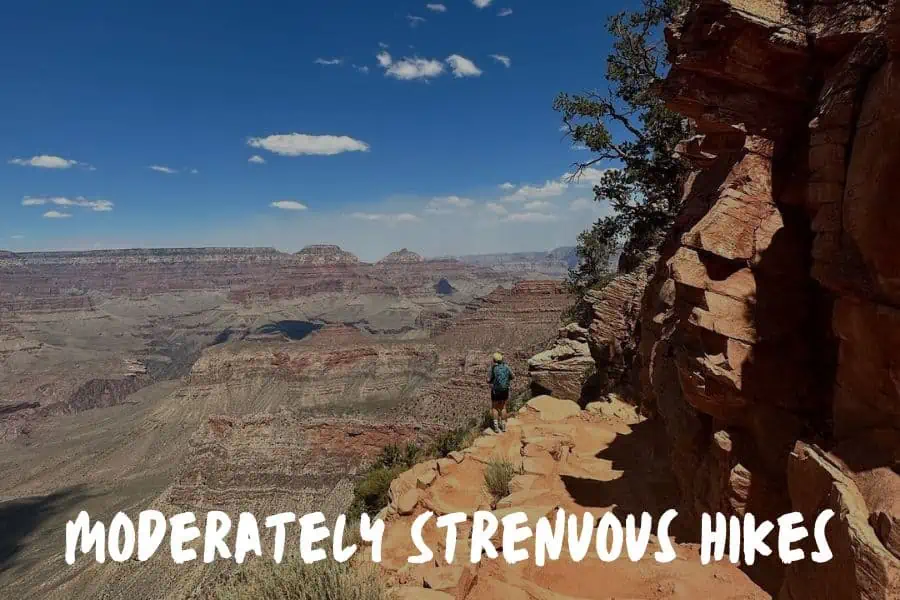
Moderately strenuous hikes are a bit more challenging than moderate hikes.
You can expect the fitness level required for these hikes to be a bit more demanding than your typical moderate hikes.
A moderately strenuous hike will be a borderline strenuous hike or something that would be considered “rugged” by some standards.
Elevation Gain
This kind of hike is going to have a higher elevation gain.
You can usually expect an elevation gain of 1,000 feet to upwards to a few thousand feet.
Expect a lot of hilly conditions along a moderately strenuous hiking trail, too.
If you’re not in the best shape, a trail like this might not be as fun as you hoped because of the physical demand it will require from you.
Terrain
The terrain on a trail with this difficulty rating will likely be challenging.
You’ll likely run into deeper creek and stream crossings.
Some of these crossings may even require off-trail hiking to get to a better area to cross.
Hills will probably be steep and technical, with many rocks.
Hiking a terrain like this will require more attention to detail and safety recognition.
Length
Trails like this might be longer in length or even shorter, but with a lot of technical difficulties.
I consider these to be between 4 and 10 miles long.
But it’s usually safe to assume that a moderately strenuous hike will likely be long both in time and length.
Trail Types
These trails in my area are usually around 10 miles long and are mostly out-and-back trails.
I do a few of these hikes a year as a fitness challenge.
But my normal hiking throughout the year is basically training for these hikes because they’re so demanding.
Best for: advanced to expert hikers
Strenuous Hikes
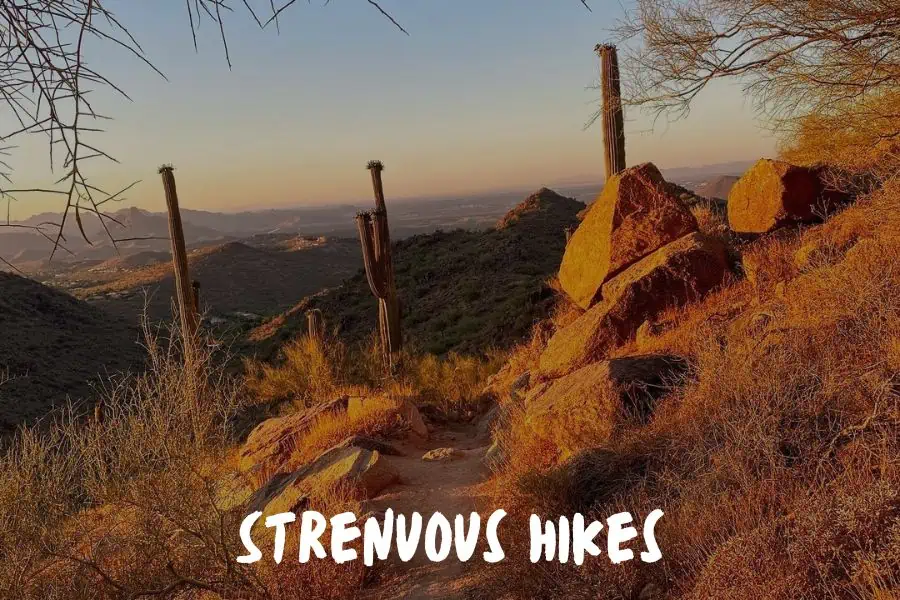
A strenuous hike is reserved for expert hikers who are in excellent hiking condition.
Many of these types of hikes are your smaller thru-hiking trails.
Note: A thru-hike is a type of trail or hike that has two trailheads (point-to-point) with a significant amount of distance between them.
These must usually be completed in one trip, requiring several nights spent overnight on the trail. (Ex. Appalachian Trail [AT] or Pacific Crest Trail [PCT])
I would consider my local 160-mile River to River Trail a strenuous hike if you’re doing the whole trail at once during the week or something like that.
These trails will require much physical strength.
Elevation Gain
You should expect a significant amount of elevation gain on strenuous hikes.
Mountainous trails are strenuous hikes simply because of their elevation changes.
On these hikes, you might even reach an elevation that makes you feel sick because you’ve never been that high.
These types of trail usually require training in higher elevations to effectively and safely prepare for this elevation change.
Terrain
The terrain of a strenuous trail is likely going to be exceptionally challenging, as well.
It will probably be reserved for the most in-shape and technical of trail hikers.
I would expect numerous stream crossings, switchbacks, rocky hillsides, and poorly maintained conditions.
These trails are usually not maintained because they are too difficult to get into the area to maintain it.
You might even find places where the trail doesn’t exist anymore and will require off-trail travel to get back to where you can find the trail again.
Length
A strenuous trail will be much longer than most.
Trails like the River to River Trail in Illinois and the Ozark Trail in Missouri are strenuous hikes because of their significant lengths.
Trail Types
In my experience, most strenuous hiking trails will be out-and-back or point-to-point type of trails.
Best for: expert hikers
Very Strenuous Hikes
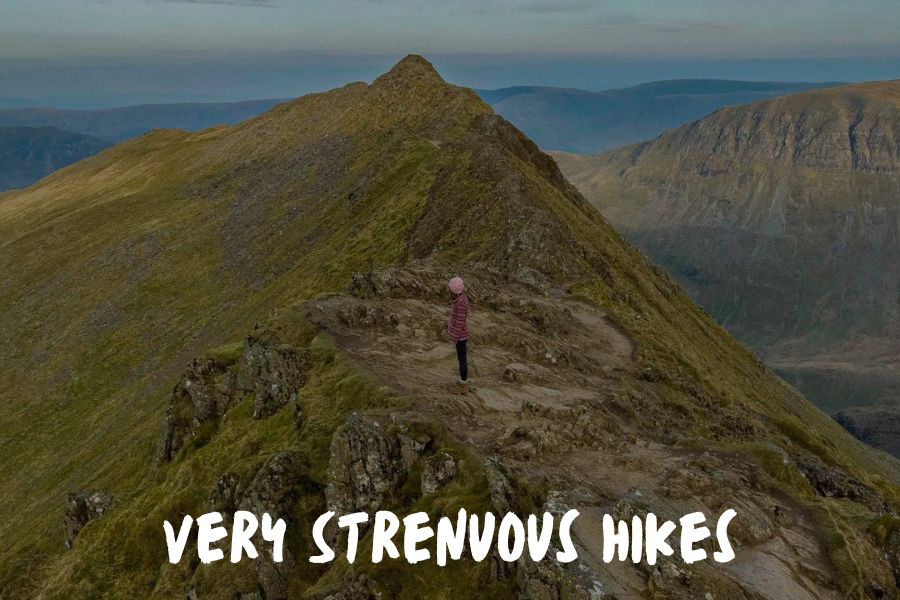
A very strenuous trail is basically going to be a mountain climb.
I would rank climbing Mount Everest as a very strenuous hiking trail.
These will be the kind of hikes that will result in significant injury or likely death if you don’t do them right.
These kinds of conditions are not for everyone. I wouldn’t even want to do things like this.
Elevation Gain
The elevation gain for these types of hikes is going to be thousands upon thousands of feet.
Terrain
The terrain will also probably include climbing-conditions.
This means you’ll have to wear climbing gear and know how to climb a mountain.
If the climbs are extremely hard, some very strenuous hikes have guides to help you through the trail (like Mount Everest).
Some of these hikes will even require air masks to ensure that you can keep breathing in the higher altitudes.
Basically, for the hiking difficulty scale, these will be the most challenging hikes you’ve ever experienced.
I wouldn’t expect to see many actual trails on a strenuous hike.
They will require you to find your own best route up and down mountains and harsh terrain.
Length
The distances will also be long – like a thru-hike, but worse.
It is a given you will need to camp overnight for multiple nights a week.
Very strenuous trails like the AT and PCT will take months to complete.
Some might take upwards of a year. These hikes are very strenuous on the body or even the mind because of the distance you must cover.
Trail Types
Most often, very strenuous hikes are going to be out-and-back or point-to-point type of trails.
You will not find many (if any) loops trails of this difficulty.
Best for: expert hikers (may even require a guide)
Different Rating Systems
Let’s take a look at different hiking difficulty scale formulas from around the world.
Shenandoah National Park

Shenandoah National Park is located in the Blue Ridge Mountains of Virginia. The park has established its own hiking difficulty scale for visitors.
They use the following formula to determine the numerical rating:
difficulty = √(elevation gain x 2 x # of miles)
That number is then coincided by a descriptor of easiest, moderate, moderately strenuous, strenuous, or very strenuous.
Easiest
Numerical Rating: less than 50
There are several easier hiking trails within the park. Many of these trails are geared toward hikers with children, older people, or tourists just looking for a quick hike.
These trails are usually under 5 miles long and walkable by most.
There is plenty to see along these trails, and they are well-maintained.
These trails are generally shorter, with gentle slopes and modified trail conditions to make hiking easy for everyone who uses them.
Moderate
Numerical Rating: 50-100
These trails are slightly more difficult than the easier trails in the National Park boundaries.
Hikers can expect longer trails with steeper inclines and uneven terrains, and they will generally be between 5 to 8 miles long.
Because of these moderate conditions, hikers need to have some established hiking experience and be in fairly good shape before they use the trails.
Strenuous
Numerical Rating: 150-200
These hikes are considered challenging by most hikers. They are generally longer and steeper and between 7 to 10 miles.
These are considered tough due to extreme elevation gain and required endurance.
Very Strenuous
Numerical Rating : greater than 200
These trails are the hardest trails to hike in the National Park.
They will require trail users to be in the best possible condition and have plenty of hiking experience.
Hikers can expect tough elevation gains, very steep terrain, and areas with limited maintenance.
These trails are usually 8+ miles long.
Willamette National Forest

Willamette is a National Forest located in Oregon. This forest contains over 1.6 million acres of diverse forested land.
There are large lakes, rivers, and mountains within it, and the US Forest Service has designated its own hiking difficulty rating for its variety of hiking, mountain biking, horseback riding, and wheelchair-accessible trails.
These ratings are based on trail material, steepness, elevation gain, and terrain.
Easy
Easy trails have around a 20% grade, making them less hilly for the area’s conditions.
The trails are usually well maintained and wider in width, making them easy to hike and not get lost.
Many of these trails are made with gravel to ensure they remain maintained and easy to hike.
Most of the easy trails within the forest are shorter.
Moderate
These trails will typically have a 30% grade, meaning they will have slightly more hills and elevation gain than the easier ones.
You can expect trails to be more narrow than the easier ones, but they are still fairly easy to recognize and follow.
Many of the moderate trails will have uneven terrain with roots, rocky conditions, and even logs across the trail.
Difficult
Willamette National Forest considers hiking trails to be difficult when the grade is over 30%.
You should expect tougher elevations, especially as you hike into any mountainous areas.
The trails will also be harder to hike and smaller in width.
You can expect steeper conditions and very uneven terrain.
Yosemite Decimal System (YDS)

Yosemite National Park has developed its own difficulty rating system.
It was mainly invented for climbing and mountaineering.
This system uses “classes” rather than descriptive indicators of how difficult a hike is.
Many parks and forests use this system as a standard rating scale.
YDS Explained
- Class 1 is basically a simple trail. The terrain will be relatively flat, with little risk of injury. It is appropriate for hikers of all ages and experiences.
- Class 2 is still a relatively easy hike. It may involve some steep inclines that will require rock scrambling (using the hands for support to walk up an incline). In some cases, rope may be necessary for extra safety.
- Class 3 conditions are more hazardous and will have steeper inclines than the first two classes. These hikes will involve scrambling and some climbing, meaning you should carry rope and make use of natural handholds. At this level, falls could be fatal.
- Class 4 means the hike will surely require rock climbing with the use of ropes. The climbing conditions will be mostly vertical, but there may still be some handholds to use for scrambling. This is the greatest combination of hiking and climbing in this system.
- Class 5 is reserved for technical climbing ratings. There will be few instances of “hiking” on these expeditions. This class is also divided into a smaller decimal breakdown to further describe the intensity of climbing conditions.
This system then goes on to assign “grades” to symbolize how many hours it might take someone to climb within the hike.
- Grade I: a few hours of climbing
- Grade II: about half a day of climbing.
- Grade III: half a day+ of roped climbing.
- Grade IV: about a full day
- Grade V: may require an overnight stay / a hike that lasts an entire day
- Grade VI: 2+ days of technical rock climbing
- Grade VII: at least a week to complete all climbing
Hiking Project: Difficulty Ratings
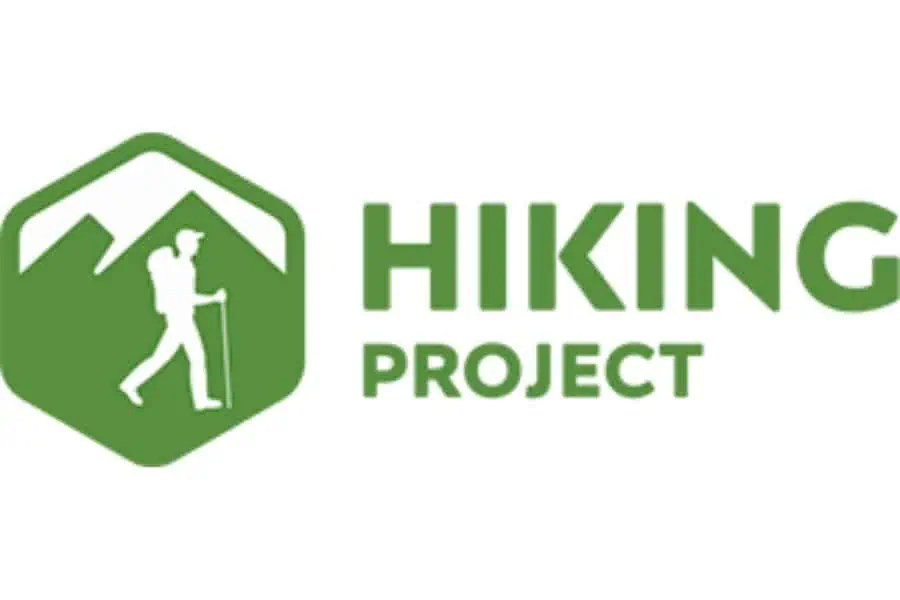
The Hiking Project was a site originally created by REI to showcase various trails before OnXMaps acquired it.
The trail difficulty rating is much like the rating systems we’ve discussed already, with some added sections in between.
These ratings apply to various trail activities – including hiking, mountain biking, and trail running.
When viewing trail descriptions on the site itself, the hike difficult will be indicated by the following colored lines:

Here is what each of the difficulties represent:
- Easy – This rating is flat and designated for trails with no obstacles.
- Easy/Intermediate – This rating is assigned to trails with uneven terrain that are still considered flat.
- Intermediate – These trails have some moderate inclines with uneven terrain.
- Intermediate/Difficult – This rating is for trails with rocks, roots, and steep sections.
- Difficult – This rating is for trails that are steep and tricky to navigate.
- Very Difficult – This rating is for very steep trails that could be hazardous for some hikers.
Swiss Alpine Club (SAC) Swiss Hiking Scale
The Swiss Alpine Club (SAC) is based out of Switzerland.
The SAC has created its own hiking difficulty scale based on conditions you would likely experience in the Swiss Alps.
These regions are typically colder, snowier, and mountainous, which is important to remember.
- T1 – This is for simple hiking trails. Specialized equipment is not required, aside from normal hiking gear. These trails are easy for just about any type of hiker and most are established footpaths.
- T2 – This is for mountain hiking. The conditions require that you be physically fit and experienced with hiking to avoid dangerous conditions. These trails are typically obvious footpaths with extra-secure exposed areas. While no major equipment is required, you’ll still need to wear appropriate footwear with a good tread.
- T3 – This is for difficult mountain hikes, which are usually steeper and more uneven. The terrain will require some scrambling, and there is a risk of falling. Some special hiking equipment might be necessary.
- T4 – This is considered alpine hiking, which does not always involve an established path. You will have to use your hands to climb up and down rocky terrain and alpines. Durable equipment and footwear will be required. Having some Alpine hiking experience will help.
- T5 – This is for difficult alpine hiking, which will usually not have an obvious or exposed trail. You will need specialized equipment like mountaineering boots and rope for this difficulty, but the climbs are considered easy for experienced alpine climbers.
- T6 – This is considered very difficult alpine hiking, mostly pathless and wholly climbing. The terrain on these hikes are very dangerous – including some snow-free glacier climbing! This level of hike is reserved for those with extensive alpine climbing experience.
Additional Tips For Assessing Hike Difficulty
Do Your Research

You should always research the hiking trail before you plan a trip.
Check out any websites, maps, trail guides, and reviews of the trail that you can find.
User reviews will inform you of the difficulties that typical resources fail to include.
Then, check the weather, the water level in creeks and rivers, and the wildlife in the area before you go.
Lastly, always designate someone as the emergency contact and make sure you show them exactly where you plan to hike.
Consider Your Personal Abilities
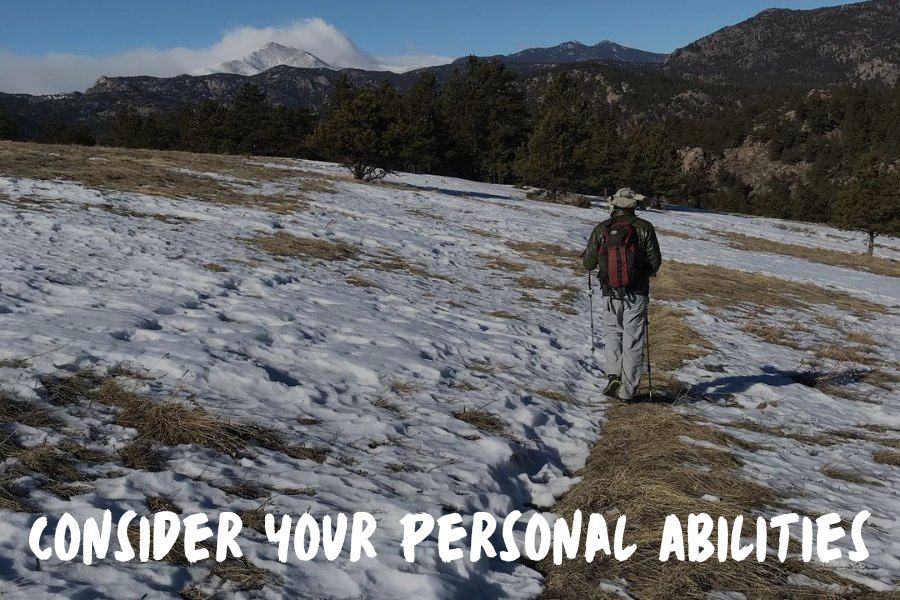
Consider your own personal fitness level and hiking experience before you take on difficult hikes.
I like hike anywhere from 5 to 10 miles on weekends, and I try to do everything in the daytime and rarely do overnight backpacking trips.
Even though I hike regularly, I wouldn’t be ready to thru-hike with my current experience. I would need to train with more overnight backpacking trips.
At the end of the day, make sure that you train and get in shape before you attempt harder trails.
Prepare For Your Hike
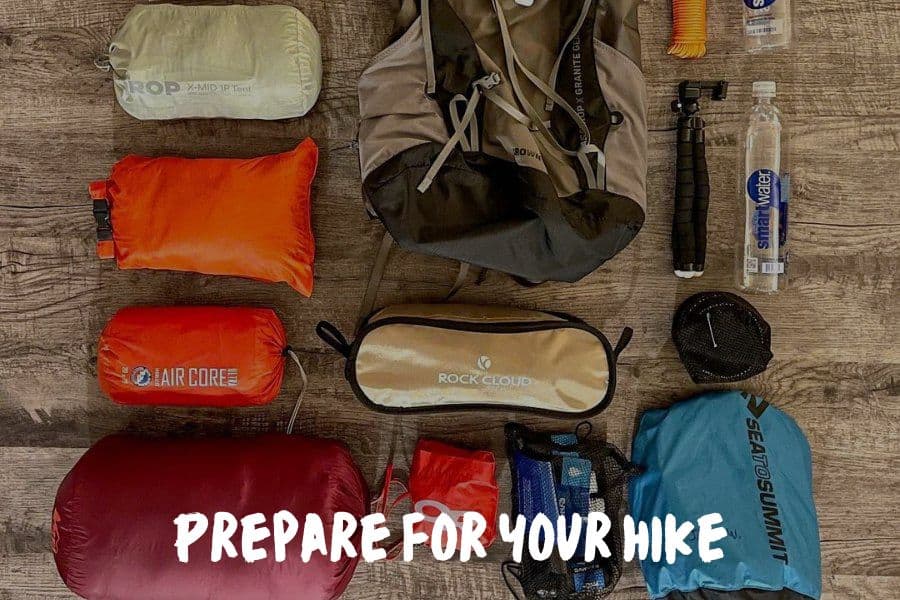
You should prepare yourself for a hike before you go, so make sure you wear appropriate clothing and footwear.
Make sure you bring the right gear with you. You should also bring a good first aid kit and extra survival items, just in case.
Make sure you have maps of the area, and try to hike with a friend if you can help it.
If not, always designate someone as an emergency contact if you don’t return.
They should know details about when and where you’ll be hiking.
If you’re prepared, you will enjoy all aspects of your hike.
FAQs
How Does Elevation Gain Affect Hiking Difficulty?
The higher the elevation gain, the harder the hike will be. Basically, elevation gain describes the hilliness of the trail.
A hike with about 100 feet of elevation is relatively flat.
A hike with 1,000 feet of elevation will be hillier and more strenuous if you’re not prepared for those types of conditions.
How Do I Estimate The Average Pace For A Hike Based On Its Difficulty Level?
Typically, the average pace of a 2- to 3-mile hike takes about an hour.
So, if you add elevation gain to it, you can usually add another hour if the gain is higher to accommodate for rests.
Can I Rely Solely On A Difficulty Scale To Determine If A Hike Suits Me?
You shouldn’t. Instead, you should properly plan hikes based on research for the specific trail, your own experience, and your level of physical activity.
You are a better scale than the various rating systems different organizations provide.
The best judge if a trail is good for you is you, so do research thoroughly and be honest with yourself about what you are capable of hiking.
How Do I Improve My Hiking Skills To Tackle More Difficult Hikes?
Start with the basics. Go hike every easy trail you can find.
Hike each trail a few times. Use a fitness app to track your performance hiking the trails.
Then, start moving to moderate trails and continue to increase the difficulty.
It also helps to do off-trail fitness, such as biking, running, and even yoga.
The healthier and the better shape you’re in, the harder the hiking trail you’ll be able to hike as you gain hiking experience.
How Can I Better Prepare For A Hike With A Higher Difficulty Level?
Train for it. Go on regular hikes and walks in easier conditions and trails right under the difficulty rating of the trail you want to visit.
More hiking is the best way to get better at hiking.
Conclusion
Many different systems exist for many different areas, but every hiking difficulty scale relates to one another via factors like elevation gain, terrain, length, and trail type.
Ultimately, you shouldn’t attempt to hike a very strenuous trail if you’ve never hiked a day before in your life.
Safe hiking takes careful planning and lots of research.
But once you’ve done that, you’ll be able to fully enjoy the beauty of nature.
More on Hiking:


